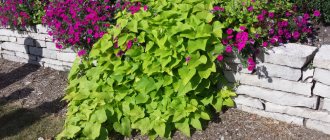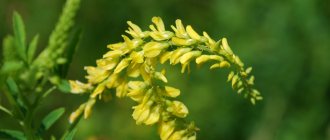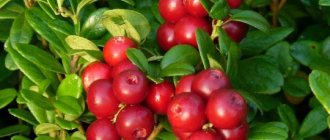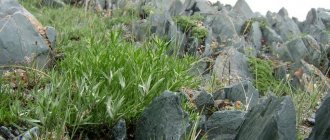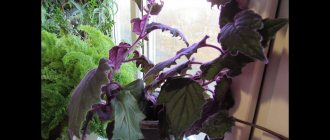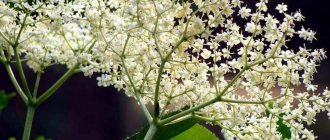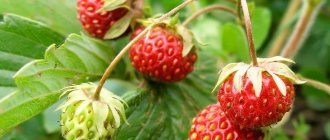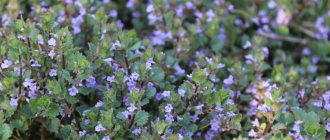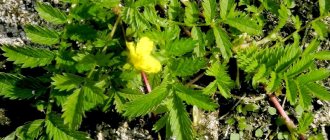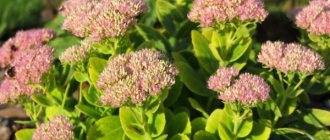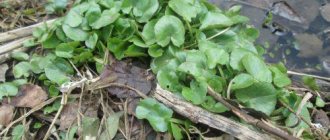What kind of plant is it with greenish fruits - balls and is it edible (cm)?
What is the name of this plant?
It grows in central Russia, usually near paths. It has fruits in the form of small round pillows, which children call “buns” or “gingerbreads” and consider edible. Unfortunately, these “buns” are hard to see in the photo, but you can see them.
I found it, Google helped :) also the name is such, it’s really not decent to eat it)) Low mallow, in Latin its more pleasant name is (Malva pusilla). By the way, I found it by googling “ball plant”. They write that it is edible.
In many places you can find this plant, which is popularly called “kalachiki” or “gypsy turnip”, and scientifically called “low mallow”.
This plant is used in treatment, and almost the entire plant (roots, leaves) is used. Decoctions are made from it, but the small fruits can be eaten; they taste sweet.
The plant is called low mallow or Malva pusilla in Latin. Its fruits are tasteless, but they can be eaten. In the city, mallow most often grows on the site of demolished houses and in garbage dumps. Its fruits are edible; probably all the children in the yard ate them in childhood; we called them “wheels.”
Very similar to an ordinary cuff.
This plant is very common in our region, small in height, considered an annual, and can grow anywhere. Basically there is a lot of it along the road, in parks and vacant lots. Its fruits are truly edible, and in general, low mallow can be used for medicinal purposes. Firstly, its decoction is used for peptic ulcers, as well as for coughs with difficult to separate sputum. Also, my grandmother at one time made lotions from mallow if someone got burned. They greatly relieved the pain.
Description
Forest mallow (Malva silvestris L.)
Synonyms: forest mallow, wild mallow, kalachiki
The malvaceae family is Malvaceae.
The flowers, leaves and roots of the plant are used for medicinal purposes.
It grows in fields, along roads, near houses, near fences - in the central and southern zones of the European part of Russia.
Forest mallow is an annual rough-hairy plant with a straight and branched stem up to 1 m high; leaves are alternate, crenate-toothed, rounded, 5-7-lobed. The flowers are large (up to 30-40 mm in diameter), collected in bunches, several in the leaf axils. The petals are deeply notched pink, gradually narrowing into a marigold; after drying they turn dark purple. The roots are long and branched. The fruit is dry, breaking up into several achenes when ripe. The plant blooms from June to August. The leaves are collected along with the flowers, and the roots are collected in the fall.
Botanical characteristics of mallow
Mallow is a one- or biennial herbaceous plant from the mallow family. It has branched stems 30–120 cm high. The leaves of the grass are rounded, heart-shaped, five- or seven-lobed, with serrated edges. The flowers are whitish-pink, small, appear in July and bloom until August. The fruits of the mallow are balls. The plant has many species; it grows wild along roads, in parks, in vacant lots, and in vegetable gardens. Cultivated varieties decorate the front gardens of amateur gardeners; the flowers of these species are larger.
Beneficial properties of mallow
The herbaceous plant is rich in vitamins and proteins, ascorbic acid, and carotene. The leaves contain water, nitrogenous substances, and sugars. Green fruit rolls contain large amounts of ascorbic acid and anthocyanin compounds, including malvina chloride. The plant has a softening, enveloping, soothing and anti-inflammatory effect.
The use of mallow
In folk medicine, the entire above-ground part of the plant is used. An infusion of flowers and leaves is taken for lung diseases, sore throat, tracheitis, dry cough, and restores hoarseness and loss of voice. Rinsing eliminates inflammation of the tonsils and oral mucosa. Lotions are effective for burns, inflammation of the eyelids, tumors and rashes of various etiologies.
Mallow decoction: pour 1 tablespoon of the herb with a glass of boiling water, leave for 2 hours and take 1-2 tablespoons orally 3-4 times a day. For lotions and rinses, the concentration of the decoction should be increased. The beneficial properties of the herb, due to the abundance of mucus, have a laxative effect in chronic constipation and help get rid of intestinal atony.
Mallow is part of the herbs used for menopause.
Mallow flower
It is useful to drink tea from mallow flowers for pain in the stomach, liver, intestines, flatulence and diarrhea.
Mallow infusion: 10–15 grams of mallow flowers need to be brewed in 1 liter of boiling water, leave for 10 minutes, strain. Drink 3-4 glasses a day for colitis and inflammation of the gastrointestinal tract.
Types of mallow
In nature, there are several types of mallow. They all have the same properties and practically do not differ in appearance.
Low mallow is an annual plant that blooms with white flowers from June to August; raw materials are harvested during the same period. In folk medicine, an infusion of flowers or leaves is used for colds, to reduce irritation and inflammation. Mucus plays the role of an adsorbent and removes toxins. For a dry, debilitating cough, it is useful to take remedies internally and externally for catarrh of the throat and hoarseness. Hot baths with the addition of herbal decoction help with spleen tumors.
Forest mallow (Forest mallow)
Mallow is a perennial herbaceous plant of the mallow family (Malvaceae). Wood mallow is found in the wild. Introduced into culture.
Flowers, leaves, stems, and roots are used in medicine. Mallow infusion is used to gargle for inflammatory and cold diseases. The roots and aerial parts are used to treat conjunctivitis and blepharitis. Leaves and flowers - in the form of compresses for tumors.
Many Siberian children know this plant and call it kalachiki, mouse turnip. This grass settles in inhabited places, along the roadside, in gardens and wastelands. The mallow blooms with very small whitish-pink flowers until autumn. The leaves are rounded and heart-shaped, usually facing the sun with their blades. If it is very hot, they curl up to reduce evaporation, and in the evening they expand again. Its fruits and leaves can be put in salads: they have a sweetish, pleasant taste. They contain up to 20 mg% carotene, up to 220 mg% vitamin C and other beneficial substances. It was mallow that decorated the dinners of the ancient Greeks and Romans with life-giving greenery.
Malvaceae family - MALVACEAE
Description . Biennial (less often annual or perennial), pubescent or almost glabrous herbaceous plant 30-120 cm high. Tap root, branched. The stem is erect or ascending, hairy. The leaves are alternate, long-petiolate, 5-7-lobed, serrated along the edge, rounded-heart-shaped in outline. The flowers are white or pinkish, located 2-3 in the axils of the leaves. The fruit is dry in the remaining calyx and disintegrates into kidney-shaped achenes. Blooms from July to September.
Geographical distribution . The European part of Russia, the Caucasus, some areas of Central Asia.
Organs used : flowers, less often leaves.
Chemical composition . All parts of the plant contain a large amount of mucilage, ascorbic acid (in leaves 3%, in flowers - 1%), carotene (in leaves about 0.05%), anthocyanin glycoside malvin C29H35O17Cl, which breaks down during hydrolysis into malvidin chloride C17H15O7Cl and two glucose molecules . The seeds contain 10-18% fatty oil.
Application . An infusion of wild mallow flowers and leaves is taken orally as an enveloping agent (due to the presence of a large amount of mucus) and an anti-inflammatory agent for catarrhal inflammation of the intestines and bronchi. It is used externally for rinsing the mouth and throat, as well as for poultices.
Forest mallow is an old folk remedy. A sweetened infusion of flowers or leaves is used for colds, inflammatory processes of the digestive tract and constipation; Externally - in the form of a gargle for hoarseness, as a wound-healing agent for burns and inflammation of the skin, hemorrhoids and other diseases in the form of ointments and emollient poultices, in a mixture with other plants, it is recommended for hot baths for spleen tumors.
Article on the topic: Common clove - useful properties, description
In folk medicine of Central Asia, a decoction of mallow leaves with sugar is used for coughs, and the seeds are used as a laxative (XX Khalmatov, 1964).
In Chinese medicine, mallow roots are used for bronchitis.
In Tibetan medicine, the roots are used as a diuretic.
In Tajikistan, the roots are used to treat hemorrhoids, gonorrhea, coughs, stomach diseases, dysmenorrhea, and diarrhea.
In folk medicine, mallow leaves are used for erysipelas and scrofula. It is believed that mallow has an antispastic and diaphoretic effect.
A decoction of the whole plant is used to treat ulcers, dyspepsia, enterocolitis, diabetes, as an expectorant, enveloping, emollient for pulmonary diseases, tuberculosis, angina pectoris, liver compaction, periodontal disease.
A decoction of mallow is used for anuria.
Mallow leaves are used for gastritis, colitis, and dysentery.
The seeds are used for skin diseases and cystitis.
Essence from freshly harvested plants is recommended for the treatment of vitamin deficiency.
The decoction is used for tumors of the legs, mammary glands, and heart diseases.
A decoction of leaves combined with nettle flowers and birch leaves is used for syphilis.
The roots are used for whooping cough (Plant Resources, 1986).
Mallow infusion is used for severe hoarseness (Sklyarevsky, 1970), pain in the stomach, intestines, liver, cystitis, flatulence (Solodukhin, 1989), sore throat, laryngitis, nephritis (Sviridonov, 1992).
For a tumor of the spleen, make hot baths from a collection of herbs - mallow 200 g, Chernobyl 150 g, chamomile flowers 150 g, oat grains 150 g. The mixture is poured into 5 liters of boiling water, infused during the day, boiled in the evening and poured into the bath, the required amount of water is added . The bath is taken at night, lasting 20-25 minutes (Popov, 1973).
Mallow is effective for inflammation of the pancreas.
To prepare an infusion from mallow, take 3 tablespoons of the raw material per glass of boiling water, boil for 10 minutes, cool, filter and take 1/4 cup 4 times a day before meals (Pastushenkov, 1990).
Avicenna recommended taking mallow seeds in the form of a decoction in case of poisoning as an emetic.
From the poem “Ode from Men” it is known that the mallow root “relieves toothache and excites love.”
Ancient doctors teach that mallow softens the stomach, the roots of the scraped mallow promote stool, help during childbirth and are useful for regulation (Rabinovich, 1991).
In Mongolian folk medicine, the seeds were used for dropsy, edema, and cardiovascular failure. It is believed that mallow helps to inhibit the processes of exhaustion. Mallow was recommended for sperm incontinence (Khaidov, 1985).
Description of the mallow
Mallow, or mallow, is a herbaceous plant from the Malvaceae family. The stems of the crop are branched, up to 120 cm long, and can be either straight or creeping. The root is taprooted, thin, with numerous lateral branches. The leaves are rounded-heart-shaped with several lobes and a serrated edge, up to 6 cm in length, with bare or slightly pubescent sides. The color of the leaf plates of the mallow is rich green and bright.
From July to August the plant bears small whitish-pink buds. On the stalks they are located one at a time, but at the same time the mallow is covered with inflorescences abundantly, so in mid-summer it becomes very decorative. Upon completion of flowering, fruits appear in place of the buds - schizocarps in scientific language and “kalachiki” in popular parlance. Both the fruits and other parts of the mallow are completely suitable for internal consumption; they do not have poisonous properties.
The perennial is native to Central Asia, but currently it grows almost all over the world. In Russia you can see kalachi in Crimea and the Krasnodar Territory, in Siberia and the Far East, in the middle zone. Mostly, mallow is found near roads and in vacant lots, in parks and vegetable gardens.
Short description
Everyone knows this plant and loves it. In total, more than 400 species of rolls are known in the world, which can be annual or perennial. Almost all varieties bloom for almost a whole year and are a decoration for any interior.
Advantages of rolls (geraniums)
- Some time ago, this plant lost popularity due to the appearance of other exotic flowers, but now it is again regaining its leading position in home flower collections of gardeners. Geranium has a number of undeniable advantages.
- Firstly, this is a brightly flowering beautiful plant that has a long flowering period and does not require special care.
- Secondly, the rolls have a specific aroma and healing properties. The smell drives away many pests, including indoor ones.
- Kalachiki can be grown both indoors and in the garden. There are a lot of varieties, and you can choose to suit every taste. The plant was brought from South Africa. From the 15th to 16th centuries it became a favorite, first in the homes of aristocrats, as a decorative and elegant plant, and then gained popularity among all segments of the population.
Features of cultivation - general recommendations
- In winter, this flower needs to be kept at a cooler air temperature than in other months of the year. However, it should not be less than +10 degrees.
- Unlike many indoor flowers, kalachiki (geranium) is not afraid of the sun and loves it very much. You can place this flower on the south side, and it will delight you with lush greenery and beautiful inflorescences.
- The plant is exotic and tropical, so it can delight its owners with flowering almost 365 days a year. To do this, you need to provide good care and the right amount of light.
- In order for the bush to grow in breadth and be fluffy, you need to periodically pinch the tops of the branches. Flowers that have bloomed should be removed immediately so that they do not take nutrients from the plant. Plants also need pruning.
- Kalachiki rarely get sick, and the cause is poor care and excessive watering. Gray rot and black leg are a consequence of waterlogging of the soil.
Chemical composition
In folk medicine, the properties of mallow are valued due to its rich chemical composition. The leaves, stems and flowers of the plant contain:
- ascorbic acid and carotene;
- mucus;
- phenolcarboxylic acids;
- terpenes and flavonoids;
- anthocyanins;
- tannins;
- mono- and disaccharides.
Of particular value in the composition of mallow is malvin glycoside, a substance with mucolytic properties that is included in many expensive cough syrups.
Compound
Mallow is an annual or biennial herbaceous plant of the Malvaceae family. A distinctive feature of the plants is the branching stem, reaching 120 -150 m in length, and rounded, heart-shaped leaves.
Distributed throughout Europe, the Caucasus, and Central Asia. Other names: forest mallow, kalachiki, mouse turnip, zansiver, neglected mallow. In total, there are more than 120 types of mallow, but the most common are forest and low. They are the ones most often used in treatment:
- Forest mallow is found everywhere: in parks, vegetable gardens, meadows, clearings, along roads, in landfills. The erect, branched stem is densely covered with small but rather stiff hairs. The flowers are purple-pink or pink-violet, shaped like an elongated cone. They bloom in July-August. The fruit is a ball, breaking up into many separate fragments.
- Low mallow is mainly found in wastelands and along roads. The stems rarely grow above 20 cm in height. It blooms with small whitish-pink flowers. Herbalists claim that the fruits and greens of this type of plant are the most delicious and sweet.
All types of mallow herb differ in the color of the flowers and the height of the stems (this is noticeable in the photo), but have the same medicinal properties . All parts of the plant in which the following are found are used as medicinal raw materials:
- terpenes and terpenoid compounds;
- phenols and their derivatives;
- phenolcarboxylic acids;
- coumarins.
In the above-ground part of the greens, ascorbic acid was found in high concentrations, vitamin A, water, coloring, nitrogenous, sugary, mucous and tannin substances. Rolled fruits contain malvacic and sterculic acid and fatty oils.
Beneficial properties of mallow
Medicines based on perennial plants:
- relieve inflammation during colds and infectious diseases;
- remove phlegm from the bronchi and lungs during coughs and severe respiratory ailments;
- eliminate skin irritations and rashes due to dermatitis;
- accelerate tissue healing from burns and cuts;
- stop diarrhea and prevent dehydration;
- alleviate the condition of chronic gastritis and pancreatitis;
- remove toxic substances from the body in case of poisoning;
- help cope with diseases of the genitourinary system;
- relieve inflammation in the oral cavity and help with eye ailments.
Contraindications
Before taking advantage of the medicinal properties of mallow, you need to familiarize yourself with the list of contraindications and recommendations for use.
Although the plant does not accumulate toxic components, doctors do not recommend taking the drugs to pregnant women, since in a certain concentration the decoctions cause uterine contractions and can cause miscarriage.
The drugs are also not prescribed for children under 7 years of age and people prone to allergies. Before starting the course, it is advisable to consult a doctor .
The use of mallow in folk medicine
Homemade health recipes suggest using the beneficial properties of the kalachi plant internally and externally. The herb has very few contraindications, and it produces a healing effect quickly.
For bronchitis and sore throat
To treat colds, the properties of mallow leaves and flowers are used. This infusion helps with sore throat and dry cough:
- 1 large spoon of dry raw materials is poured with a glass of boiling water;
- keep covered for about 2 hours;
- filter and drink up to 4 times a day.
A single dosage of this beneficial infusion is 2 tablespoons; you need to take the product on an empty stomach. The properties of mallow soften the throat and promote the removal of mucus, eliminating hoarseness and hoarseness. The product is also suitable for rinsing with inflammation of the tonsils; the concentration can be increased and brew 2-3 large spoons of herb.
For healing wounds and burns
The beneficial properties of low mallow promote rapid healing of damaged skin. To treat burns, cuts and wounds, prepare the following infusion:
- 4 large spoons of dried herb are poured into 500 ml of boiling water;
- keep covered for about 40 minutes;
- filter.
You can use the properties of mallow infusion for lotions: a cotton pad soaked in the product is applied to sore spots for 15-20 minutes twice a day.
Another recipe suggests preparing a medicinal mixture, namely:
- mix 10 g of chamomile flowers, marshmallow root and sweet clover herb;
- add 30 g flax seeds;
- measure out 40 g of the healing mixture and pour boiling water in such a volume that you get a thick paste.
After this, the wet mixture should be wrapped in a piece of gauze and applied to the damaged area until the mixture cools.
You can speed up the healing of damage using the valuable properties of a strong mallow tincture. To prepare it, pour a glass of dry roots and leaves into 1 liter of vodka and leave for 2 days. Then the product is filtered and the affected areas are wiped.
For diseases of the gastrointestinal tract
The green parts of the perennial mallow help with pain in the stomach, intestines or liver, relieve constipation and bloating. There are several useful proven recipes.
Infusion of leaves for gastritis and pancreatitis
The following remedy helps eliminate inflammatory processes in the stomach and pancreas:
- 1 large spoon of dry mallow leaves is poured into 1 liter of boiling water;
- keep for an hour under a closed lid;
- filter through cheesecloth.
You need to take half a glass of the drink half an hour before your main meal.
Infusion of roots for bloating in the abdomen
With increased gas formation, the properties of the plant roots have a good effect. The recipe looks like this:
- dried mallow rhizomes are crushed in the amount of 2 large spoons;
- pour a glass of hot water;
- leave for 15 minutes and filter.
Drink half a glass of the remedy three times a day; the infusion must first be slightly warmed.
Medicinal collection for intestinal colitis
A collection of several useful herbs can help get rid of intestinal pain and improve the condition of gastritis. Do it as follows:
- mix mallow, chamomile and calendula in equal parts;
- pour 100 g of dry collection with a glass of hot water at about 80 ° C;
- cover with a lid and leave for 50 minutes.
You need to drink 150 ml twice or thrice a day warm.
Decoction of mallow flowers for constipation
The medicinal properties of the squat mallow help not only with diarrhea, but also with constipation. To cleanse the intestines, you need to prepare this useful decoction:
- half a large spoon of vegetable raw materials is poured with 250 ml of boiling water;
- keep the mixture in a water bath for 15 minutes;
- cool under the lid and filter.
You need to use the product up to 4 times a day; the effect of the medicinal properties of the decoction occurs the very next day.
To boost immunity
For weakened immunity and a tendency to catch colds, mallow-based tea is beneficial. Necessary:
- pour 15 g of dried flowers into 250 ml of boiling water in a teapot;
- cover with a lid;
- leave for 5 minutes, and then pour into cups through cheesecloth or a special strainer.
Methods of application
The strained decoction (15.0 - 200.0) is drunk for diseases of the larynx, trachea and lungs, 1 glass five times a day.
The first decoction-mixture (used for the same diseases): wild mallow flowers, buckwheat, coltsfoot, wild poppy and lungwort herbs are mixed equally; 50.0 mixture is brewed in 5 glasses of water and drunk one glass five times a day.
The second decoction-mixture (for baths; with an enlarged spleen) : 200.0 leaves and flowers of forest mallow, 150.0 each of Chernobyl herb, chamomile and oat grains; the mixture is poured into 25 cups of boiling water, left for a day, boiled in the evening, poured into the bath and the required amount of water is added. The bath is taken at night (duration: 20-30 minutes).
Using mallow in cooking
The properties of mallow herb are used not only in health recipes, but also in the kitchen. Soups are prepared from the leaves of the plant, added to cabbage rolls instead of cabbage, boiled and consumed with feta cheese or hard cheese. The greens of the perennial plant are used in okroshka and improve the taste of regular scrambled eggs.
Mallow salad
You can make a low-calorie, tasty and healthy salad from perennial leaves. The ingredients you will need are the following:
- onions - 50 g;
- fresh mallow leaves - 300 g;
- 100 g carrots;
- 50 g each of horseradish and mayonnaise;
- dill, parsley and salt to taste.
Making the salad is very simple - blanch the mallow leaves in boiling water for 5 minutes, then cut them and pour them into a glass container. Chopped onions and carrots, grated horseradish are also added there. The salad is salted according to your own preferences, seasoned with mayonnaise, and topped with dill and parsley.
It takes very little time to prepare the dish - only about 10 minutes. And the salad brings significant benefits, since it saturates the body with vitamins and minerals from vegetables and herbs.
Herbal caviar from mallow
You can prepare unusual caviar from the fresh leaves of a perennial plant. The process will require additional ingredients, namely:
- nettle - 40 g leaves;
- sorrel - 30 g;
- 2 small cloves of garlic;
- 25 g onions;
- salt and ground black pepper to taste;
- 25 g tomato sauce and 15 ml olive oil.
To prepare caviar, you need to thoroughly wash the leaves of the plants and blanch them for a minute. Then the greens are loaded into a blender and chopped properly, sautéed and onions are added. The whole mixture is poured with tomato paste and sprinkled with pepper and grated garlic and salt. At the last stage, the ingredients are sent to a saucepan or deep saucepan and simmered for another 15 minutes on the lowest heat.
Reproduction methods
There are several basic methods that gardeners use when breeding rolls. Let's see what is needed for these events.
Seed method
- Unlike many plants, this option for propagating geraniums does not present any difficulties at all. The seed material germinates very well and the germination rate is almost 100%.
- If you plant seeds from balls that you have at home, the grown plant will differ from the mother plant, as it will lose its varietal characteristics. This is especially true for hybrids.
- You can prepare a nutritious soil mixture yourself, mix the following components: 1 part - peat, 1 part - river sand, 1 part - turf soil. Before planting, you need to moisten the soil. After planting, sprinkle the seeds on top with the same soil. You can sprinkle a layer of moistened sand no more than 1.5 cm.
- Before planting, the soil is disinfected with a solution of potassium permanganate so that the rolls do not get sick with such a dangerous disease as “blackleg”.
- Next, the planted seeds are covered with film or glass and the temperature is maintained at +18 - 20 degrees. When the seeds germinate, the shelter must be removed and the temperature reduced slightly to +16 - 20 degrees. Place the container in a sunny place.
- After 2 months, several independent adult leaves will grow. Then you need to carry out the picking procedure, that is, plant the sprouts in separate small pots.
- If there are 5 - 6 leaves, it is advisable to pinch the upper parts of the shoots so that the crown becomes lush and grows.
Cuttings
- Sprouts can be harvested after pruning and throughout the year. But the strongest cuttings will be those cut in the spring.
- Their length should be 7 - 8 cm, leave a few leaves on each. Next, dry the sprout for 24 hours, and treat the cut area with finely crushed activated carbon.
- Then plant the sprout in a nutrient substrate. It should be very loose; you can even use moistened sand.
- When moistening the substrate, avoid getting moisture on the leaves and stems of the plant. The room temperature should be about 22 degrees Celsius.
- There is no need to cover the cuttings. When the cuttings take root, they are then transplanted into permanent pots.
Harm of mallow and contraindications
The medicinal properties and contraindications of low mallow are related to each other. But in general, the plant does not contain toxic substances, and even with an overdose it is quite difficult to encounter symptoms of poisoning. However, the use of rolls is not recommended:
- with individual intolerance;
- during pregnancy and while breastfeeding;
- with a general tendency to allergic reactions.
You need to be careful when trying mallow for the first time, this applies to both culinary dishes and drinks. If 3-4 hours after using the product there is no nausea, abdominal pain or skin irritation, then the properties of the perennial plant can be used without fear.
Care
Water the plants as the soil dries out. Kalachik is a flower that loves moisture, but it should not be flooded. In summer, the ball is watered more often, and much less frequently during the dormant period. But still, the soil must be constantly moist.
Excess moisture comes out through the pan. But the drainage in the pot must be of high quality.
The roll does not need to be sprayed. He loves dry air.
Kalachiki are indoor flowers. But in summer they feel better in the fresh air.
And feeding them won't hurt. It is carried out once every two weeks with liquid complex mineral fertilizer. You can use the “Bud” product.
Preparation and storage
The underground and above-ground parts of the plant are equally suitable for medicinal purposes; they have equivalent beneficial properties:
- Mallow roots are collected in mid-spring, before the flowering period begins, the perennial is dug out of the soil and the numerous shoots extending from the main stem are cut off. They will need to be washed and blotted with a paper towel, and then laid out to dry in a dry but protected from direct sun place.
Dried medicinal raw materials should be stored in breathable fabric bags in a dry place away from light. If the rules are followed, mallow can retain its beneficial properties for 3-5 years.
Reproduction
Kalachik is a flower that is easily propagated by cuttings. They are broken off or cut off from the side branches or tops. The length of the cutting should be from 5 to 7 centimeters and have at least two leaves. Plant immediately in a permanent place in light soil. The cut area is treated with ash.
You can take cuttings all year round. But it is better to do this in the spring - in March or April, and in the fall - in August and September.
Cuttings help improve the appearance of the plant. If it is very long and the flowers are placed only at the top, cutting off the top causes the growth of lateral shoots from dormant buds. Later they will be covered with flower stalks.
Withered flowers are removed so that new ones can form as quickly as possible.
Horse sorrel
If in those villages where Soviet children spent their summers, there was little cultivated sorrel growing, then they happily ate horse sorrel. People also call it aveluk, frog or horse sorrel, thick sorrel and hernia moth. The taste of this herb is more specific than that of common sorrel. The horse “variant” is distinguished by a less sour taste, as well as the presence of bitterness, the degree of which depends on the age of the plant: the older it is, the more bitter it is. In young leaves, the bitterness in the taste is almost not felt. And since this type of sorrel grows everywhere and has long been classified as a meadow weed, there is so much of it in the villages that there has always been more than enough for all local and visiting children.
In some countries, for example, Azerbaijan, Armenia and Uzbekistan, parts of the plant are widely consumed.
Description
The plant is 10-50 cm tall, green with a thin long tap root. The stems are numerous, straight or erect, less often recumbent, usually branched from the base, sometimes dirty purple below, covered with sparse simple hairs or bare.
The leaves are long-petiolate, with a kidney-shaped blade, 2-6 cm long and 3.5-8.5 cm wide, with five full semicircular lobes and two poorly developed marginal ones, irregularly toothed or almost crenate along the edge. The leaves are glabrous above or sometimes between the lobes with sparsely scattered hairs; below they are also glabrous or with a few simple hairs along the veins, rarely completely pubescent with simple hairs. The petioles are densely pubescent along the groove above, and almost bare in the rest of the part. Stipules are green, lanceolate, almost glabrous, with long ciliated edges.
Flowers are 2-10 in the axils of the leaves almost from the base of the stem, on pedicels that are two to three times longer than the flowers, becoming much elongated with fruits. The bracts are similar to the stipules, paler, filmy. Subcups of three narrow linear leaves. The calyx is cut up to ⅔ into ovoid-triangular lobes, mostly bare, covering the fruit. Corolla whitish or pale lilac; petals are oblong-lanceolate, slightly notched at the apex, up to 10 mm long, no more than 1.5 times larger than the calyx, barely protruding from it.
The fractional fruits are divided into 8-12 mericarps, glabrous or short pubescent, the lateral edge is reticulate-wrinkled, the ribs are raised and sharp.
Chemical composition
The leaves contain up to 85% tannins, and the fruits contain 0.1% ascorbic acid. According to other data, the leaves contain 112.2-243.2 mg%, and the fruits contain 30 mg% of ascorbic acid. The leaves contain 10.2 mg% carotene. There are no alkaloids in all parts of the plant, but there is a lot of mucilage.
The carbohydrate octocosane is found in the grass, the anthocyanin malvidin is found in the flowers, and up to 18% green fatty oil is found in the seeds.
The best edible weeds from our childhood
When I was a child, we ate whatever we could get our hands on. Flowers, leaves, twigs. Either we lacked delicacies, or we are children of nature, so we compensated for the deficiency of vitamins in the body with folk remedies. I remember we ate many berries and herbs and didn’t even know what they were called.
Only when we grew up did we learn their names. These were: cattail, wormwood, clover, white acacia, sedge, lilac flowers, green maple shoots, nettle leaves and many other plants.
Our childhood was not difficult, but on the contrary, very joyful, healthy and carefree. The children did not know what anemia or vitamin deficiency was, despite the fact that we did not know about the existence of kiwi, bananas, and mangoes. I decided to remember my childhood passions and talk about the plants I ate as a child.
I remember how I ate young stalks of colza, first removing the skin, it was delicious. Its bright and shiny rosettes of leaves are very striking. The plant grows in damp places, along the road, on the bank near a river. It grew near every house here.
As far as I know, young greens are used in salads, and unripe inflorescences are stewed like broccoli. You can also prepare soup, puree, and side dishes from young stems. It is also an excellent filling for pies and casseroles. I haven’t tried it myself, but they say it’s very tasty. The plant tastes like arugula.
Gum from fruit trees
For a gardener, gum visible to the naked eye on a cherry or plum is a reason to shout “guard.” And for Soviet children, amber droplets were a great joy, because in their taste and appearance they are similar to cockerels made of melted sugar. But such sweets were not given out for free in the markets, and melting sugar at home risked ruined dishes and severe punishment from parents. While gum (which the children called resin among themselves) was easy to get from the tree and eaten with pleasure. That's what we did. And you?
- Why do cherries ooze gum?
The gum, or sap, of stone fruit trees can be beneficial to humans. But for the garden its appearance is a bad sign. Find out why.
Helpful information
In China and the Caucasus, mallow is grown as lettuce or parsley for human consumption. Fresh herbs are added to salads, soups, and casseroles. The leaves are boiled and pounded in a trough to make a pie filling or side dish from the greens. Dry leaves are ground and added to dishes as a seasoning.
The fruit rolls are pickled and added to solyankas, savory snacks, and sauces for savory dishes. Flower extract is used as a natural dye for tinting homemade alcoholic drinks and vinegar.
Decorative varieties of mallow traditionally decorate summer cottages, rural vegetable gardens, and flower beds. They are often planted as a hedge. Flowers are absolutely unpretentious, reproduce on their own, and sometimes grow so intensely that they cause anxiety and unnecessary trouble for gardeners.
